The day before Jack Frost decided to make overnight visits to our parish, I acquired a lift over to Blunts that would give me a two-mile walk back to Quethiock.
When I got out of the car beside the old telephone kiosk that now houses a defibrillator, the surrounding ground was covered in newly grown leaves of cow parsley.
A couple of these plants were in bloom with their small white flowers that once had the name ‘Queen Anne’s lace’
At the crossroads where roads lead to Holwood Farm, Pillaton and St Ive, I photographed the road sign that was unreadable.
I think this was done during WWII when road signs where either removed or made illegible to render them useless to enemy parachutists should they land nearby.
Strange that passing councillors have not noticed that this sign was never renovated!
Walking the stretch of road that is known as ‘The Broadway’ by locals, I could see several yarrow plants in bloom growing on the wide hedge creep.
Yarrows have tall, stiff stems with clusters of feathery fern-like leaves consisting of many fine leaflets, hence the Latin name, millefolium (thousand leaves) and topped with a display of flat, white flowers.
However, the prettiest picture that I observed on the walk was when I looked towards Kit Hill and saw thick mist above the path of the River Lynher.
In the foreground were Leigh Woods and Holman’s Woods, then on the far side of the mist covered river is Leigh Plantation.
Above that are some fields and then Kit Hill with the stack just visible. I heard a murmur that a flock of starlings had been seen in the parish and sure enough, when I looked out the window at the birds’ feeding station, there were three starlings fighting to get at the fat balls.
Oddly, I don’t seem to have noticed starlings during the summer months, but we get a large number that cross the English Channel to spend the winter here.





Comments
This article has no comments yet. Be the first to leave a comment.